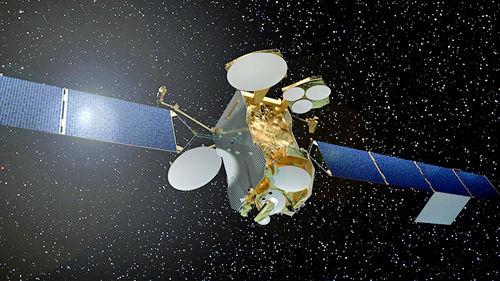
EUTELSAT 172B, the first high power all-electric telecommunications satellite, will be shipped on March 20 from the Airbus satellite assembly facility in Toulouse to Kourou, French Guiana, for Eutelsat.
The satellite will be launched into orbit on an Ariane 5 in April,and will provide enhanced telecommunications, in-flight broadband and broadcast services for the Asia-Pacific region. EUTELSAT 172B combines electric power of 13 kW with a launch weight of only 3,500 kg. The satellite hosts three distinct payloads that will strengthen Eutelsat’s capabilities across APAC markets: a C-band payload, a regular Ku-band payload and a high throughput Ku-band payload designed for in-flight connectivity along Pacific air corridors. The satellite also incorporates other state-of-the-art features, in particular the flexibility to dynamically distribute power between the 11 elliptical beams in the high throughput payload.

Artistic rendition of the EUTELSAT 172B satellite.
Image is courtesy of AIRBUS.
Underpinning EUTELSAT 172B is Airbus’ highly reliable Eurostar E3000 platform in its latest EOR (Electric Orbit Raising) evolution. Innovative deployable robotic arms will be used to orientate the satellite’s electric propulsion thrusters and to control thrust direction and attitude as needed during the different phases of the mission. A proprietary network of ground stations around the world will allow Airbus engineers to control orbit raising operations until the satellite reaches geostationary orbit.
The development of Airbus’ Eurostar all electric platform has been supported by ESA and space agencies of European countries, in particular in France by CNES in the framework of the PIA program (Plan d’Investissements d’Avenir)
“We are the first company to demonstrate full electric propulsion for satellites of this size and capacity,” reported Nicolas Chamussy, Head of Space Systems at Airbus. “With this spacecraft, we are clearly setting a new benchmark - enabling powerful and complex satellites to be launched in the most cost efficient manner.”
Arnaud de Rosnay, the Head of Telecommunications Satellites at Airbus, added that using electric propulsion for initial orbit raising and all on-station maneuvers has led to a substantial weight reduction, enabling the satellite to be launched in the Ariane 5 lower position and offering more competitive launch costs.

